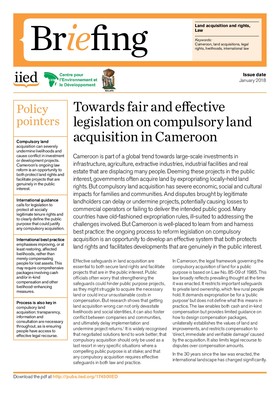Apes, crops and communities: land concessions and conservation in Cameroon
Cameroon’s current land law appears to have two conflicting objectives: to attract investors through large-scale land concessions while simultaneously protecting biodiversity, defending local people’s rights and promoting rural development. But the legislation governing large-scale land-based investments is outdated and sometimes incoherent. The land allocation process is investor driven and does not appropriately balance economic, social or environmental considerations.
Towards fair and effective legislation on compulsory land acquisition in Cameroon
Cameroon is part of a global trend towards large-scale investments in infrastructure, agriculture, extractive industries, industrial facilities and real estate that are displacing many people. Deeming these projects in the public interest, governments often acquire land by expropriating locally-held land rights. But compulsory land acquisition has severe economic, social and cultural impacts for families and communities.
Land in German Development Cooperation: Guiding principles, challenges and prospects for the future.
“Land matters” – more than ever! Can land be dealt with like other resources or – in terms of an economic perspective– forms of capital. Or does it attract particular meanings, sentiments, interests, acquisition strategies or social relations?
Land Tenure in Development Cooperation. Guiding Principles
Land tenure issues are becoming increasingly important worldwide. Problems such as high population pressure, increases in resource degradation, food shortages, transformations of political systems and regional and supra-regional resource conflicts have brought the land issue to the public's attention.
Reviving land and restoring landscapes: Policy convergence between forest landscape restoration and land degradation neutrality
Countries have publicly announced their commitments to restore degraded forests and lands.This report comes at a time when many countries are fully engaged in the challenging task of implementing their LDN targets and Bonn Challenge pledges with a goal to achieve them by 2030.
Collection of Submissions on Innovative Financial Mechanisms
In terms of innovative mechanisms, economic and financial mechanisms that rely on regulationand markets to provide incentives for environmental stewardship are also relevant. These mechanisms include different types of regulations and direct or indirect payments schemes, for example tradable development rights, trading of emission reduction and payment for environmental services.
Investment based mechanisms, like microfinance, are other types of mechanism that can provide financing for UNCCD and SLM practises.
Financing Strategies for Integrated Landscape Investment: Synthesis Report,” in Financing Strategies for Integrated Landscape Investment
Policymakers and land managers around the world are struggling to use our finite land and resource base to increase agricultural production, ensure resilient ecosystems and improve livelihoods. Many are turning to integrated landscape management (ILM) as a framework for inter-sectoral planning and investments to reduce potential trade-offs and realize inherent synergies.
Food Security Funds. Finance Info Kit.
In terms of innovative mechanisms, economic and financial mechanisms that rely on regulationand markets to provide incentives for environmental stewardship are also relevant. These mechanisms include different types of regulations and direct or indirect payments schemes, for example tradable development rights, trading of emission reduction and payment for environmental services.
Investment based mechanisms, like microfinance, are other types of mechanism that can provide financing for UNCCD and SLM practises.
Assessing global land use: Balancing consumption with sustainable supply
This report explores how the management of land-based biomass production and consumption can be developed towards a higher degree of sustainability across different scales: from the sustainable management of soils on the field to the sustainable management of global land use as a whole. Under business as usual conditions, the growing demand for food and non-food biomass could lead to a gross expansion of cropland in the range of 320 to 850 million hectares by 2050.
Private-sector investor’s intention and motivation to invest in Land Degradation Neutrality
In this study, the authors aimed at explaining private-sector investors’ intention to invest in Land Degradation Neutrality (LDN) and analysing their motives for making investments that promote sustainable development. Regarding the actual intention to invest in LDN, the majority of investors showed rather weak intention to make investments that promote LDN in the near future.
Soil atlas: Facts and figures about earth, land and fields.
Without healthy soils, it is not possible to produce healthy food. But soils do not just produce food: they



